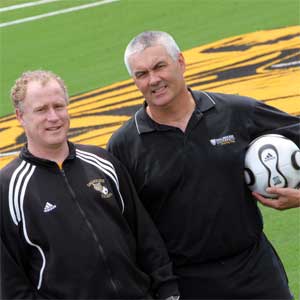 |
| Dal soccer coaches Graham Chandler and Pat Nearing check out the new turf. (Pearce photo) |
The beautiful game is about to get even more beautiful at Dal.
The new artificial turf on F.B. Wickwire Memorial Field is almost ready to go. A staff soccer game will christen the field today at lunchtime.
The field has been in the process of transformation for about two months. The old turf, put down in 1995, was replaced with ÃFieldTurf,â an artificial turf playing surface that looks, feels and plays like grass.
ÃIt is much more player friendly,â says head soccer coach Pat Nearing. ÃThe sand and rubber infill is so much easier on the legs. It has the exact qualities of playing on a grass field, without it being grass. I should be able to bump up training time by 30 per cent, which will lead to a fitter, healthier team.â
Unlike a carpet-like turf, the new surface is soft to the touch. Players can slide, tackle and tumble without fear of rug burns. Acting as a cushion and shock absorber beneath the playing surface is a mix of sand and rubber granules. The new turf will also allow for maximum drainage during rain storms so play can continue, rain or shine.Â
But if grass is the ideal, why not just go with grass?
The problem with grass, explains Coach Nearing, is that Nova ScotiaÃs growing season is so short. Moreover, a real grass field just wouldnÃt be able to stand up to the demands of AV¾ãÀÖ²¿Ãs soccer program. Community soccer programs can also be accommodated on the new field.
ÃThis field should be operational more than 80 hours a week,â he says. ÃIf we had grass, the field would be finished by the first week.â
Other improvements to Wickwire Field include having the surrounding fence extended by another 1.8 metres (six feet) to contain wayward balls and the creation of a practice Ãkickingâ wall, says Al Scott, DalÃs Director of Athletics and Recreational Services. The $1.7 million project has been funded through student fees.
Wickwire Field is AV¾ãÀÖ²¿'s main outdoor sport facility. Activities that are regularly held on Wickwire Field include all levels of soccer, ultimate Frisbee, field hockey, lacrosse, football clinics and practices and rugby. The field will see approximately 3,000 or more hours of use, annually.
